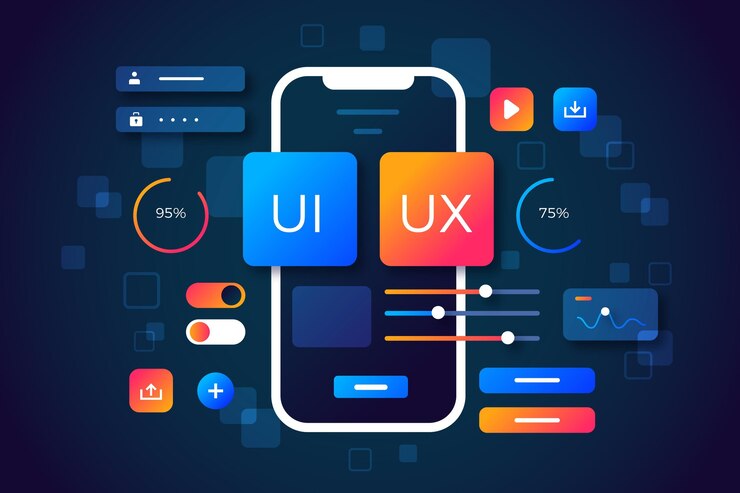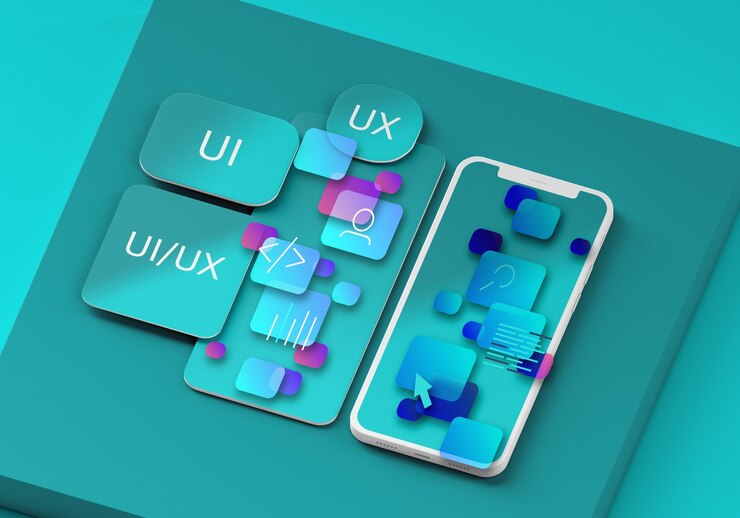User behavior is observed by a UI/UX, and front-end expert to improve an application’s visual design. They have a thorough understanding of modern technology stacks and are skilled at designing aesthetically pleasing user interfaces.
Their key aim and objective is to improve user satisfaction. The objective is also to reduce user churn and make sure that the goals of the organizations are met. Enhancing the conversion of sales, increasing the email sign-up findings, and reducing the pain points are examples.
While some designers and developers opt to specialize in one area (for example, UI/UX, or front-end programming), this profession incorporates all of them, making it a unique designer-developer hybrid. It’s critical to understand how these three areas of knowledge overlap and intersect to locate the perfect applicant.
The user’s enjoyment of your software is central to user experience (UX) design. Front-end development (UI) is a technical term for implementing a software’s user interface. The graphical link between the two is UI design.
Where Do You Get The Right UI/UX Inspiration For Your Website From?
As you may be aware, design trends shift throughout time, so it’s critical to be mindful of the 2023 trends to stay current. In this article, we’ve compiled a list of the top 15 greatest UI/UX inspiration websites that we’ve hand-picked for you to read, learn from, and be inspired by.
May these websites assist you in your own UI/UX efforts. These sites have been hand-picked to keep you up to date on the most recent design trends.
These are also the best (or still best) websites. They include the year’s most recent and up-to-date design trends.
Here are the top 15 best UI/UX inspiration websites:
Waveguide
Waveguide aspires to be a one-stop shop for design information and real-life design examples. They provide the best design assistance, recommendations, and inspiration. The Waveguide also ensures that all of their articles are of the greatest possible quality; therefore, they have a closed content creation system in place and don’t allow anyone to submit a guest post on their site (unless they’re a very experienced designer).
Every piece of content you read is a genuine production based on knowledge and experience. If you’re looking for information or inspiration, Waveguide is a good start.
Lapa Ninja
Lapa was founded to serve as a source of influence for designers. They publish a variety of designs, including blogs, e-commerce, landing sites, and more. They make certain to pick the best examples and keep their lists up to date daily.
Uplabs
Uplabs is the place to go whether you’re looking to design for the web, iOS, macOS, or Material Design. This website contains the most up-to-date information about the design of such software. User interfaces, experiments, open-source programs, libraries, and ready-to-use products are among the items available here.
Unlike the other websites on this list, Uplabs was established to allow design theory and practice experimentation. There are other tools there that you can utilize that will further your investigation.
SiteInspire
SiteInspire is devoted to showcasing the most innovative and cutting-edge web interactive design. They feature web pages that site owners have submitted to them. The site currently receives 200 submissions every day on average, and they carefully select the best sites to help you find inspiration. If you’re looking for design inspiration for your website or if you have a website with interesting graphics, you might want to check out SiteInspire or submit your design.
Dribbble
What’s the deal with “Dribbble” (yep, it’s triple B)? Because Dribbble allows users (such as you) to share miniature screenshots of their designs (known as “shots”) with other users. Isn’t it cool? Dribbble is a social media platform that allows designers to connect, share their work, improve their talents, and be hired by the world’s most prestigious firms.
Dribbble, unlike the other sites on our list, genuinely enables you to meet other creatives and designers, collaborate with them, or seek and provide advice to one another. Dribbble is the ideal platform for getting discovered by huge firms like Apple, Facebook, Google, and Shopify. If you want to be a part of this expanding designer network, go to their website and sign up!
Related: 9 Tools To Test If Your Website Is Mobile Friendly
Niice
Niice is a similar design platform; however, it serves a distinct function. Unlike Dribbble, a design-sharing platform, Niice functions as a collaborative workspace comparable to Slack or Trello. Niice, on the other hand, is designed with designers in mind. The following is how it works: Have everyone and everything in one location – this is what they term “boards,” which allow you to communicate with your team. You can upload your work there if you wish to share it with your colleagues for feedback or advancement. Easier feedback — their approach is designed to make it simple for others to provide you with comments.
Niice is built to accomplish this work for both of you, whether you need thorough input from your client or just a “Yes or No.”
Real-time feedback is offered to you! a design library – Look at the work of your teammates for inspiration or new ideas. If you’re working on a large project, Niice can be a useful tool for you and your team.
Behance
Behance is a social media site where all designers and creatives may showcase their work. Unlike other social media platforms, Behance’s primary goal is to help designers and creatives. As a result, if you want to join a community of fellow creatives, you should go to Behance and sign up.
Pinterest is one of the top image and video sites for people to develop new ideas and get inspired to accomplish what they love. This portal features information, such as designs and home décor, among many other things.The users of Pinterest can communicate by liking, commenting on, and replying to each other’s creations.
Creativity Bloq
One of our favorite design-related websites is Creative Bloq. According to their About page, Creative Bloq provides a blend of guidance and inspiration for all, including traditional and digital artists, graphic designers, web designers, 3D and VFX artists, illustrators, and more.”
True to their word, their website offers a variety of design ideas and some guidance for your upcoming projects. Creative Bloq also ensures that they stay on top of current trends so that you don’t miss out on anything.
DesignBetter.co
Design better. Co is a great place to go if you want to seek help from designers themselves. This website features short podcast shows with some of the top designers and creatives in their areas. You’ll get many useful information and ideas that will help you with your current or future projects. Listen to these design gurus, take notes, be inspired, and make something beautiful!
Prototypr.io
According to their About page, “Daily design news, inspiration, and deals: Everything you need to supercharge your design talents,” Prototypr.io is your source for news and even offers in UX and design technologies. They keep track of the most recent UX design trends, so you don’t miss anything.
They also provide a wealth of design ideas, inspiration, and recommendations to help you keep moving forward.
UsabilityGeek
As a personal pastime, Justin Misfud started UsabilityGeek in 2011 to spread the word about the significance of website usability.” His goal is to raise awareness about the relevance of usability because he believes that just a few designers and developers understand its importance at the time. He attempted to tie theoretical and practical work together in his discussion of usability.
As the blog grew in popularity (IA), it covered topics like conversion, user experience (UX), human-computer interaction (HCI), and information architecture. If you want to learn more about this topic, go to UsabilityGeek.
UX Collective
For practically any topic you can think of, there are many articles available on the Internet. UX is no exception. However, most UX papers are difficult to understand, especially for those new to the field. As a result, UX Collective was born.
It was created to write simply digestible UX content. In this way, even novice users can quickly master UX. This website may be useful if you’re having trouble reading about UX.
UX Movement
If UX Collective was created to help you understand UX principles, UX Movement was created to show you the consequences of both good and bad UX designs. The goal of the UX Movement is to teach you which UX techniques to use and which to avoid for improved human interaction outcomes.
They point out that while many UX experts prioritize functionality and design, they frequently overlook the importance of psychology and human interaction in the designs they create. The UX Movement is a behind-the-scenes look at how humans interact with UX programs and how to attain the results we want.
UX Myths
This is probably one of the simplest web pages in terms of design. Don’t be deceived, though. As the name implies, UX Myths seeks to dispel myths about UX practices. To begin with, defining exactly what UX is difficult; therefore, some of the features of UX written about can be shady and ambiguous enough. UX Myths tries to dispel this misunderstanding by separating myths from reality.
They cover not only user experience but also design and psychology. Overall, this is an intriguing site for anyone interested in learning more about UX or simply having fun. It might be enjoyable to debunk the beliefs you once believed.
Conclusion
These are the top 15 UX/UI websites to inspire you while working on your projects. The best approach to get inspired is to see a work of art or to have a new idea on how to do something.
Alongside getting the right inspiration, you should ensure that your website lives up to the UI/UX standards required by enterprises. Browser testing platforms like LambdaTest are playing a crucial role in helping web developers and testing professionals to keep their applications result-oriented, highly usable, and robust.
With LambdaTest, you can test website UI/UX across 3000+ browsers and OS combinations. You can test your website UX on a real device cloud (Android and iOS) in real-user conditions. LambdaTest also allows you to perform automated device testing on real Android smartphones and real iPhones/iPads.
These websites don’t just provide you with counsel and information, as you’ve just learned. Some of them are centered on knowledge and information sharing. Others allow you to meet and network with other designers.
While some are just there to inspire you by exhibiting actual gorgeous designs, others are more than that. Regardless of how you use these sites, we hope they provide you with one thing: inspiration, information, and ability in your field.
Read Also:























